Methods of hair transplantation
Last reviewed: 17.10.2021

All iLive content is medically reviewed or fact checked to ensure as much factual accuracy as possible.
We have strict sourcing guidelines and only link to reputable media sites, academic research institutions and, whenever possible, medically peer reviewed studies. Note that the numbers in parentheses ([1], [2], etc.) are clickable links to these studies.
If you feel that any of our content is inaccurate, out-of-date, or otherwise questionable, please select it and press Ctrl + Enter.
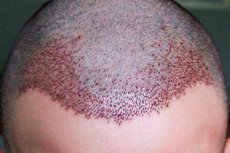
Hair transplant is a procedure during which hair from one part of the head is transplanted to another, where for some reason they are absent, representing a serious cosmetic defect. The operation is performed in outpatient settings in rooms equipped with special equipment for hair transplantation (forceps and other surgical instruments) and anesthesia.
Usually for the procedure, enough local anesthesia, when a person remains conscious, but does not feel pain in the field of surgery. But if the amount of work is large, i.e. Hair is absent on a large area of the head or body, general anesthesia is allowed, but the transplant is performed not by a large area of the skin, but by individual bulbs, which means it takes a long time. In this case, the procedure is carried out under the supervision of an anesthesiologist. Its presence is also mandatory if the patient has a predisposition to increase or decrease the pressure, allergic reactions, with certain concomitant diseases, and also if the patient has excess weight or old age.
It would seem that to get a hair with normal density, you need to take a huge piece of tissue, densely populated bulbs, and therefore should remain a large scar. In fact, everything is not so sad. The fact is that usually bulbs are located on the skin of the head in small pools of 2-4 pieces, occupying microscopic areas on the skin, so it is not always necessary to even cut out the skin flap with follicles.
But even if you take a patch of skin with individual follicles, the place of its location is neatly sutured, leaving behind a barely noticeable scar. And since the skin is usually taken on a site with a dense scalp, the scar remains covered with the rest of the hair.
Usually hair for transplantation is taken in the occipital and lateral parts of the head. Their choice is due to bulb resistance to negative external influences and the action of dihydrotetstosterone, which is the reason for their normal growth throughout life. The bulbs from the frontal and parietal parts are very sensitive, so they fall first.
The removal of natural follicular associations according to the follicular method with the use of special equipment with an implant needle does not require the use of a scalpel and other micro-instruments that violate the integrity of the skin.
But the fence of such a biomaterial as a skin flap according to the classical technique requires the doctor skills of handling surgical instruments. Moreover, afterwards the flap should be cut into small pieces of skin containing from 1 to 4 hair follicles that are implanted into the prepared incisions on the bald skin.
But there are already enough common words, it's time to consider what are the methods of hair transplantation.
The FUT method or transplantation (transplantation) of follicular associations
Implies a serious surgical operation. It is also called the scrappy method. This technique has a name for the reason that the biomaterial for transplantation in this case becomes a skin flap cut from the back of the head.
Hair at the nape or lateral part of the doctor is cut for the convenience of taking material for transplantation. The scalp at the surgical site is treated with an antiseptic. The patient is given anesthesia (local or general anesthesia). When it works, using a scalpel, cut out the area of the skin with a size of no more than 10 by 3 cm, which is later divided into grafts (units of a flap containing 1-4 hair bulbs) on the occipital part of the head densely provided with hair follicles. The site of the operation on the nape is sutured.
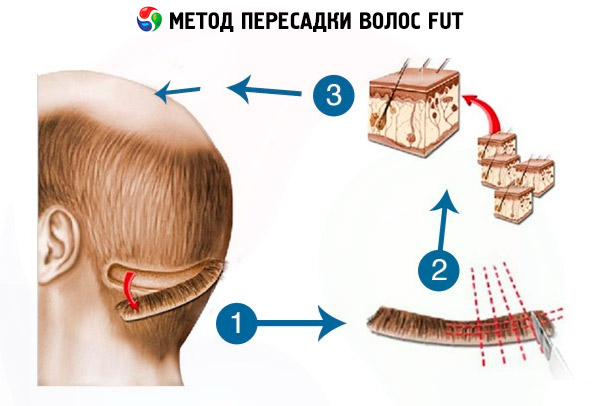
After that, on the bald patch, incisions are made, in which the prepared grafts are introduced, providing the necessary hair density. And it again will depend on the number of transplanted grafts. If the density is subsequently insufficient, additional operations are carried out.
True, the method is considered quite traumatic, so a person in his whole life can expose himself to an operation no more than 3 times. Repeated operation can be carried out not earlier than 6 months after the previous one.
A variant of this technique can be considered a strip method, in which not a flap of skin is removed, but a strip of about 20-25 cm in length. It is resorted to when the initial hair density in a person is insufficient to cover the balding area. Next, the skin at the site of the flap is sutured.
Advantages of these operational techniques can be considered:
- relatively short operation time (usually no more than 4 hours),
- the ability to achieve a good density of hair by obtaining and transplanting a large number of grafts (up to 12 thousand grafts for several procedures),
- a small percentage of damage to the hair follicles when extracting the flap,
- good survival of transplanted hair,
- relatively low cost of the procedure.
Among the drawbacks of strip-techniques are:
- a long period of wound healing at the site of the transplant, the recovery period, depending on the complexity of the operation, can take from 2 weeks to 3 months,
- loss of a part of the follicles in the collection of biomaterial,
- a large, noticeable scar on the back of the head or the side of the head where the skin flap was taken,
- the presence of small scars on the wire of incisions, where small grafts were introduced,
- painful on-site surgery,
- Transplanted in one procedure hair usually does not give a natural density.
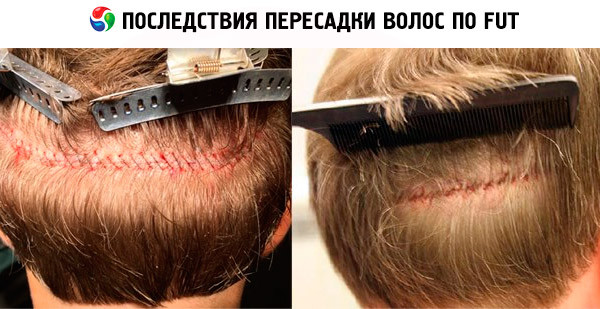
Method FUE
Absolutely different from the strip technique. It is considered less invasive than the previous one, since it does not require any large incisions, and therefore there will be no seams with visible scars.
FUE hair transplantation involves the use of special equipment - punch, which pierces the skin, removing small areas of it in 2-5 mm, containing several hair follicles (follicular associations). The procedure is also carried out after the haircut.
Then, on the affected skin, the micro cuts are made with a scalpel or punctures with a special needle into which the fonts seized by themselves are inserted. On the site of the sites where grafts were seized, small red markings remain, which are then quickly tightened and become invisible.

FUE ( seamless hair transplantation ) is recommended for baldness up to grade 4. Otherwise, if the biomaterial is insufficient, the bulbs will have to be taken on other parts of the body (on the chest, legs, beard, pubic, etc.). Hair transplantation from the body subsequently leaves no visible traces in the places where the transplant was removed, but it should be understood that the structure of the overgrown hair (those that are not taken from the head region) will differ from the others in structure, they are tougher and thick.
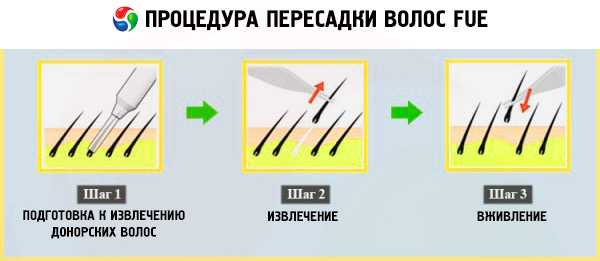
This method can also be used to restore eyebrows, mustaches, beards, eyelashes, etc., as well as to build hair on healed burned surfaces.
Advantages of this technique can be considered:
- Less than traumatic strip,
- absence of large scars after surgery,
- The presence on the spot bald spots of almost imperceptible tracks instead of microscopic scars,
- less pain in the postoperative period and less prolonged duration (usually up to 4 weeks),
- the possibility of using other donor zones besides the head,
- Grafts produced by the FUE method contain more hair follicles (when the strip method cuts the skin into small areas, they usually contain 2-3 bulbs, and with FUE, multicomponent follicular associations containing 3-4 follicles are extracted).

Despite the less traumatic and more visible picture of the patient's head after transplantation, the FUE technique has serious drawbacks:
- The duration of the operation is 2 times higher than for strip-methods,
- the FUE method allows for 1 procedure to transplant a smaller amount of hair from the area of the head, which according to the structure will correspond to unset (up to 6 thousand grafts)
- impossibility of repeated operation,
- the number of damaged bulbs is higher than in the strip method,
- transplanted hair in the process of removal and introduction back into the skin are damaged, which means that their survival rate may be lower,
- the price for seamless operation using the FUE technique is higher, because the doctor has to work a lot, removing the follicular units individually instead of cutting the skin area and giving the assistants that cut it into pieces.
In some clinics, doctors offer an upgraded version of the strip and FUE techniques, when hair is not cut before transplanting. As a result, after the operation, a person actually gets a ready haircut, and the doctor - an opportunity to evaluate the result of their labors. In this case, a person has the opportunity to cover shortcomings (traces of punctures and cuts) with hair, immediately lead a habitual active life for him.
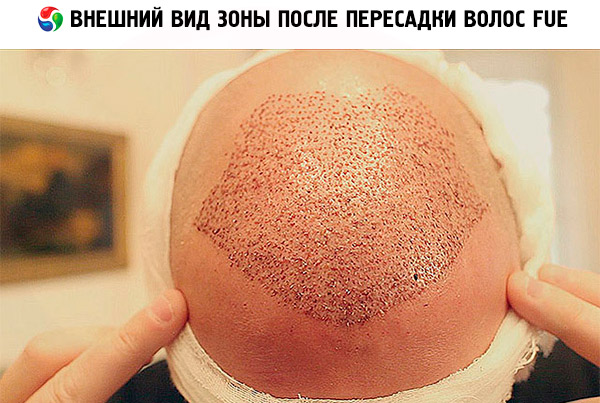
True, here there are a couple of nuances. Working with long hair is a more labor-intensive process, requiring certain skills and experience, which is not available to all specialists in this industry. Yes, and the cost of such an operation can be much higher than when working with short hair.
HFE method
This is a modern technique, the name of which stands for Hand Follicle Extraction. Sometimes the name of the technique is given a slightly different meaning, deciphering the abbreviation Hair ForEver, which you need to understand as a beautiful hairstyle or hair forever. Perhaps because the name of the method is consonant with the only clinic in Russia Hair ForEver, which performs hair transplantation using this technique.
The HFE technique is a hair transplant without surgical intervention, i.e. The doctor does not even make microscopic incisions. The whole procedure is carried out using a special instrument (needle-implanter, up to 0.9 mm in diameter, which extracts follicular associations and inserts them into the scalp on a balding area).
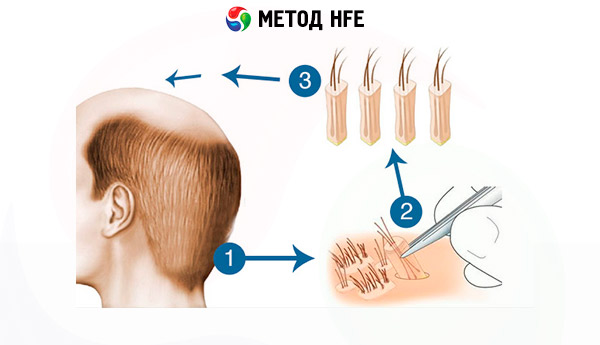
Using the implant allows you not to make preliminary incisions on the skin, and immediately transplant the bulb to a predetermined depth (usually about 1 mm) from one section of the head to the other, while adjusting the angle of inclination of the hair, bringing it as close as possible to tilting the main mass of the hair in a given area of the head. It is clear that there is no need for general anesthesia, because the procedure is less painful and less traumatic. The duration of the operation can be different depending on the treated area and the number of transplanted bulbs.
Non-surgical hair transplantation by the HFE method is gaining increasing popularity, putting aside the previously existing methods. And this is understandable, because it has a lot of advantages over them:
- low tissue trauma, at the site of hair removal there are only thin punctures of a small depth that damage the nerve endings,
- absence of any traces of surgery after the end of the recovery period and the need to stay in the hospital after surgery for professional care of the seams, as with strip technologies,
- a rather high percentage of hair survival rate (up to 98%),
- the ability to achieve the desired thickness of hair for 1-2 procedures (for 1 procedure the patient can transplant up to 6 thousand follicular associations consisting of 2-4 bulbs, which already provides a thick beautiful hairstyle, but there is still the opportunity to conduct an additional procedure and increase the density of hair double that the FUE methodology can not offer)
- short rehabilitation period: the wounds heal in 4-5 days, discomfort disappear within a couple of weeks,
- hair begin to grow actively already after 3 months after the procedure, that after the application of other techniques it is possible not always,
- the possibility of hair transplantation on the forehead, which is actual with a very high forehead line and pronounced bald patches (the surgeon delineates the forehead line where the follicular joints from the occipital part of the head are implanted).
The beard of many representatives of the stronger sex is considered an indicator of masculinity, it is clear that its absence can cause the man certain complexes, and this makes it necessary to apply for help to specialists. The HFE technique allows hair transplantation not only on the forehead and parietal part of the head, but also on other areas, for example, on the beard. After all, it allows you to achieve not only the right density, but also the right inclination of the hair. In addition, there are virtually no traces in the places where hair is introduced into the region of the beard, which is also important.
With the HFE method, in the complete absence of your hair, you can try to transplant hair from another person, but, as we have already mentioned, it does not always give the expected results. Talk about the compatibility of biological parameters of the hair of strangers usually do not have to. This biomaterial is overwhelmingly rejected by the recipient organism. As a hair donor, you can try to take a close relative, ideally an identical twin. And the risk of rejection of hair is still high. Such is our immune system, which protects the body from the invasion of foreign substances.
To date, there are proposals for the implantation of artificial hair, the transplantation of which would make life easier for patients completely hairless, if it is impossible to find a suitable donor. The success of such an operation should not be counted particularly, so it is carried out in 2 stages. First, do a trial procedure on a small part of the body and for 2-4 weeks observe the results, i.e. The reaction of the immune system to foreign body implants.
If rejection is not observed, proceed to the second stage of the procedure, implanting artificial hair (from 600 to 8000). It is clear that more hair is implanted not at once, it takes several sessions with an interval of 2-3 weeks.
Transplantation of unnatural material is extremely rare, when there are no other ways to help a person. After all, artificial hair requires further care, and even this often does not help them look natural. Usually in the first days a person is quite happy with the result, but in the future the material becomes faded, becomes tangled and loses its resemblance to natural hair.

